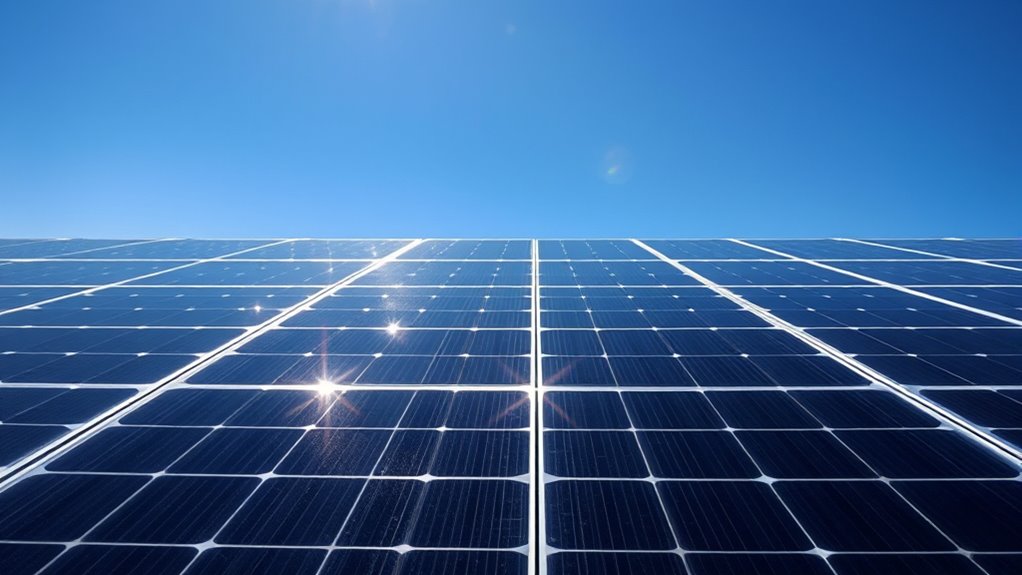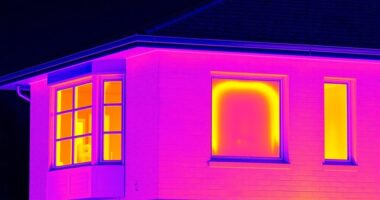Solar panels’ spectral efficiency depends on how well they absorb different wavelengths of sunlight. They work best when their material bandgap matches the solar spectrum, allowing them to convert more photons into energy. Narrow or wide bandgap materials influence which wavelengths are captured and how much heat is produced. Advances in bandgap engineering and multi-junction cells help optimize performance across the spectrum. Keep exploring to learn how these techniques can boost your solar system’s efficiency.
Key Takeaways
- Spectral efficiency measures how well a solar panel converts different wavelengths of sunlight into electricity.
- Optimizing spectral response involves selecting materials and designs that match the regional solar spectrum.
- Bandgap engineering allows tailoring of photovoltaic materials to absorb specific wavelengths for higher efficiency.
- Multi-junction solar cells combine layers with different bandgaps to capture a broader range of the spectrum.
- Enhancing spectral efficiency reduces energy losses and increases overall solar panel performance.

Solar panels are most effective when they can absorb as much sunlight as possible, but not all wavelengths of light contribute equally to energy generation. Your panels’ ability to convert sunlight into electricity heavily depends on their spectral response, which describes how efficiently they can harness different parts of the solar spectrum. The spectral response varies across different photovoltaic materials, meaning some materials are better suited for capturing specific wavelengths of light. To maximize energy output, it’s vital to understand how a solar cell’s material bandgap influences its spectral response. The material bandgap is fundamentally the energy difference between the valence band and the conduction band within the photovoltaic material. When sunlight hits the panel, photons with energy equal to or greater than this bandgap can excite electrons across this gap, generating electrical current. Photons with lower energy, however, aren’t absorbed, leading to lost potential energy. Consequently, a material’s bandgap acts as a spectral filter, determining which wavelengths can be effectively converted into electricity. Additionally, advancements in bandgap engineering enable the development of panels tailored to specific spectral ranges, further improving efficiency. If your solar panel’s bandgap is too wide, it will only absorb high-energy photons, typically in the visible or ultraviolet range, but miss out on a large portion of the infrared spectrum. This limits the overall spectral response because a significant amount of sunlight’s energy lies in lower-energy infrared wavelengths. Conversely, if the bandgap is too narrow, the panel might absorb a broader range of wavelengths but could suffer from increased thermalization losses, where excess photon energy is lost as heat. This reduces efficiency and can cause the panel to heat up, decreasing its lifespan and performance. Finding the suitable bandgap involves balancing these factors to match the solar spectrum in your region. For example, silicon-based solar cells have a bandgap around 1.1 eV, making them fairly versatile but not perfectly tailored for all light wavelengths. Emerging materials like perovskites and multi-junction cells aim to customize the bandgap to capture a broader spectrum more efficiently, enhancing spectral response and overall power output. Understanding the relationship between spectral response and material bandgap helps you make smarter choices when selecting or designing solar panels. If you want high efficiency, look for panels with a spectral response that matches the solar spectrum in your location, which is often achieved by using multi-junction cells or materials with adjustable bandgaps. By focusing on these factors, you can guarantee your solar energy system captures more sunlight across different wavelengths, translating into more electricity and better performance over time. Ultimately, fine-tuning spectral response through the right material properties allows you to get the most out of every ray of sunlight that hits your panels.
Frequently Asked Questions
How Do Weather Conditions Affect Spectral Efficiency in Solar Panels?
Weather conditions directly impact spectral efficiency by causing cloud cover and temperature fluctuations. Cloud cover reduces the intensity of sunlight reaching your panels, lowering efficiency across the spectrum. Temperature swings can cause your panels to heat up or cool down, affecting their ability to convert light effectively. You should consider these factors when installing and maintaining solar panels, as they influence overall energy production and system performance.
What Materials Maximize Spectral Absorption in Next-Generation Solar Panels?
Imagine a future where perovskite materials dominate solar tech, boosting spectral absorption markedly. Material innovations like perovskites and multilayer thin films are pushing spectral optimization forward, capturing a broader light spectrum. In a recent case study, researchers enhanced efficiency by layering materials to absorb different wavelengths. You can expect next-gen solar panels to use these advanced materials, maximizing energy capture even under less-than-ideal weather, revolutionizing solar energy use.
Can Spectral Efficiency Improvements Reduce Overall Solar Energy Costs?
Yes, spectral efficiency improvements can substantially reduce overall solar energy costs. By increasing efficiency gains, you can generate more power from the same amount of sunlight, which lowers the cost per unit of energy produced. This means you spend less on materials and installation while maximizing output. As a result, adopting advanced spectral technologies helps you achieve cost reduction goals and makes solar energy more competitive and accessible.
How Does Spectral Mismatch Impact Multi-Junction Solar Cell Performance?
Oh, the joys of spectral mismatch—your multi-junction solar cell’s kryptonite! When the sunlight’s spectrum doesn’t perfectly align with each layer’s absorption, efficiency drops faster than your hopes on a cloudy day. This spectral mismatch hampers multi-junction efficiency, causing less energy to be harvested. It’s like trying to fit a square peg into a round hole, wasting potential and money. So, yes, it’s a real energy drain!
Are There Emerging Technologies That Enhance Spectral Utilization in Solar Panels?
You can boost spectral utilization in solar panels by exploring emerging technologies like quantum dots and plasmonic structures. Quantum dots can be tuned to absorb specific wavelengths, increasing overall efficiency, while plasmonic structures enhance light absorption through localized surface plasmon resonance. Incorporating these innovations allows you to capture more of the solar spectrum, leading to higher energy conversion rates and making your solar technology more effective and versatile.
Conclusion
Understanding spectral efficiency helps you maximize your solar panel’s potential. By selecting panels optimized for the right wavelengths, you unlock the full power of the sun—like revealing a hidden treasure. Don’t settle for less when the right technology can turn sunlight into limitless energy. Remember, your choice in spectral efficiency isn’t just a detail; it’s the key that unleashes a brighter, sustainable future. Embrace it, and watch your solar investment truly shine.









